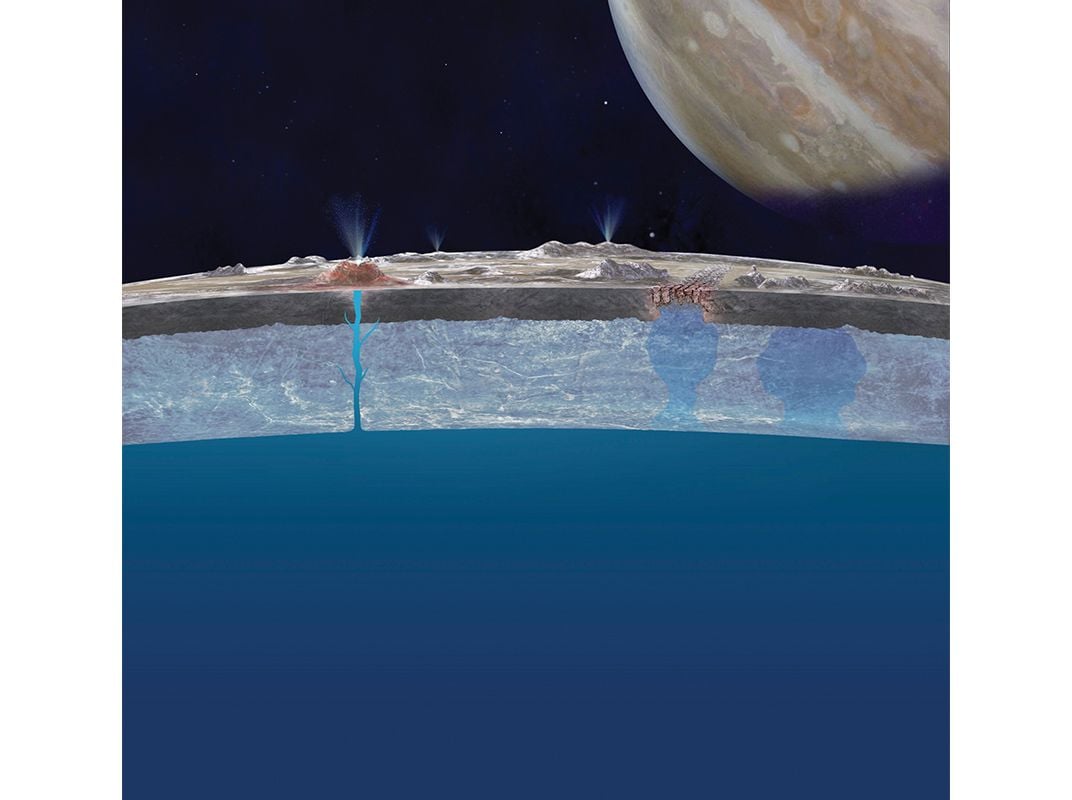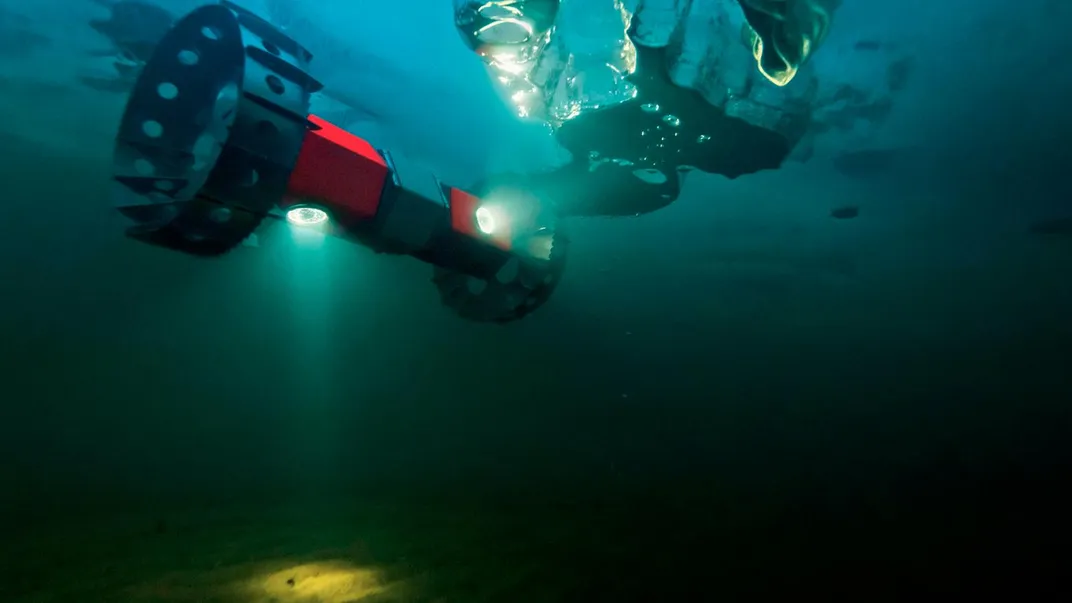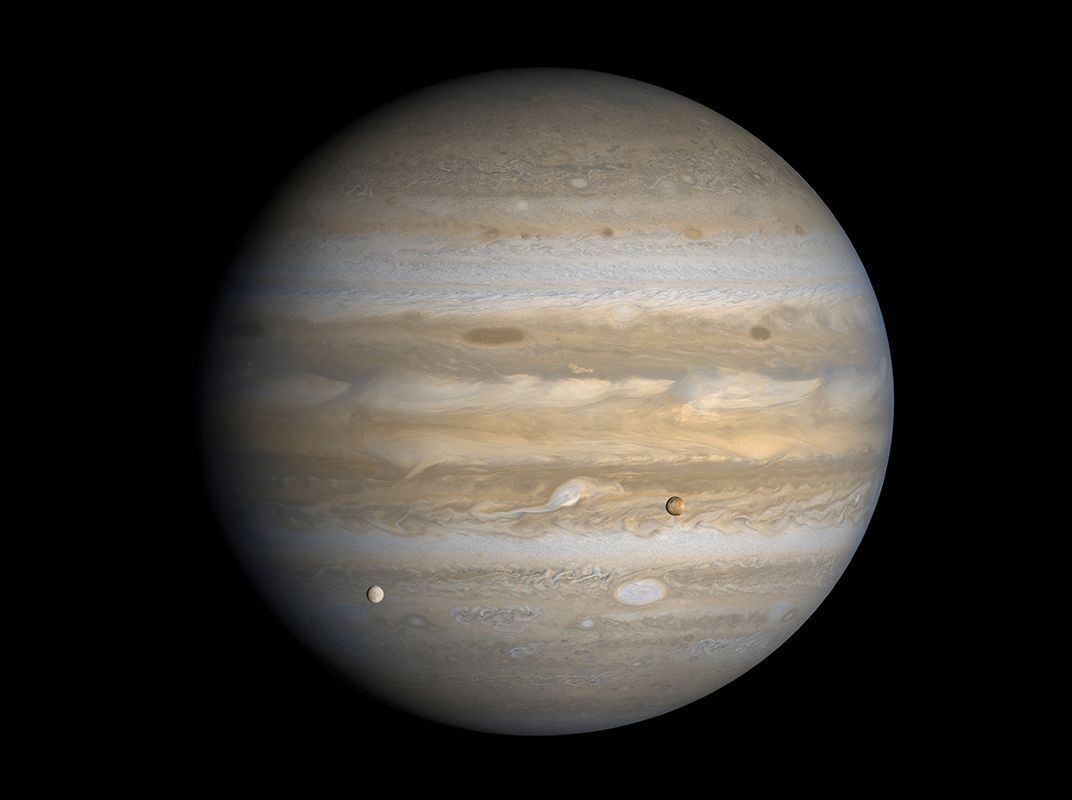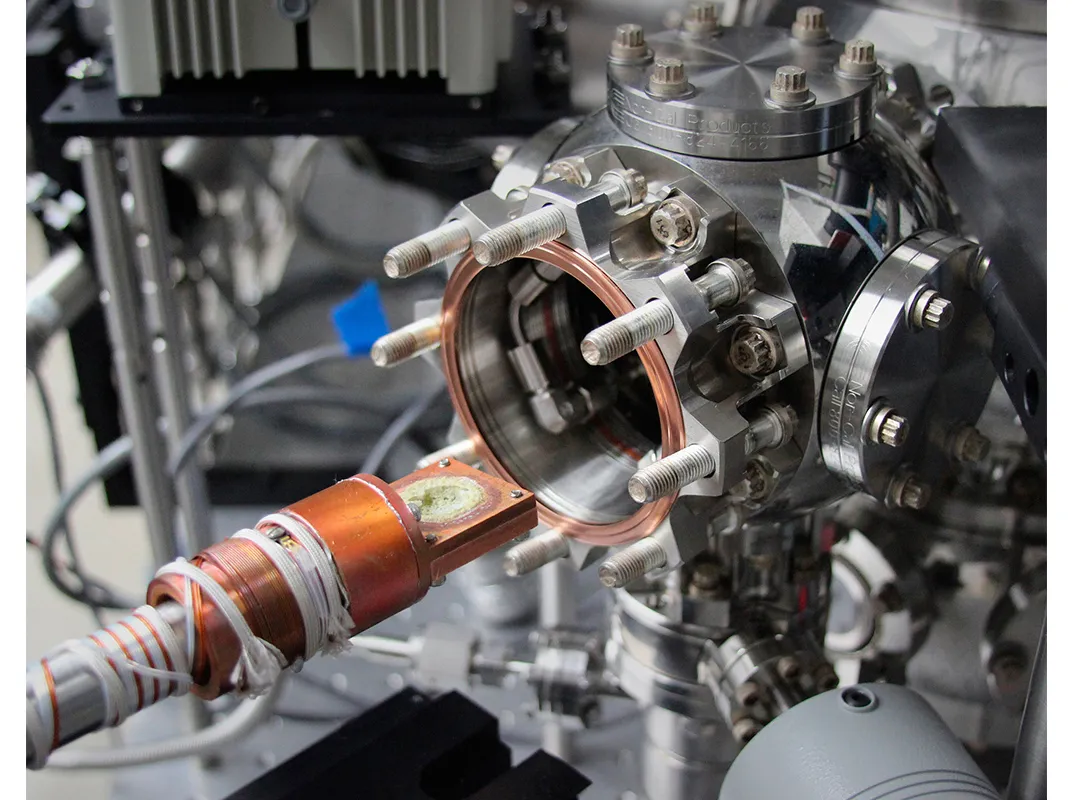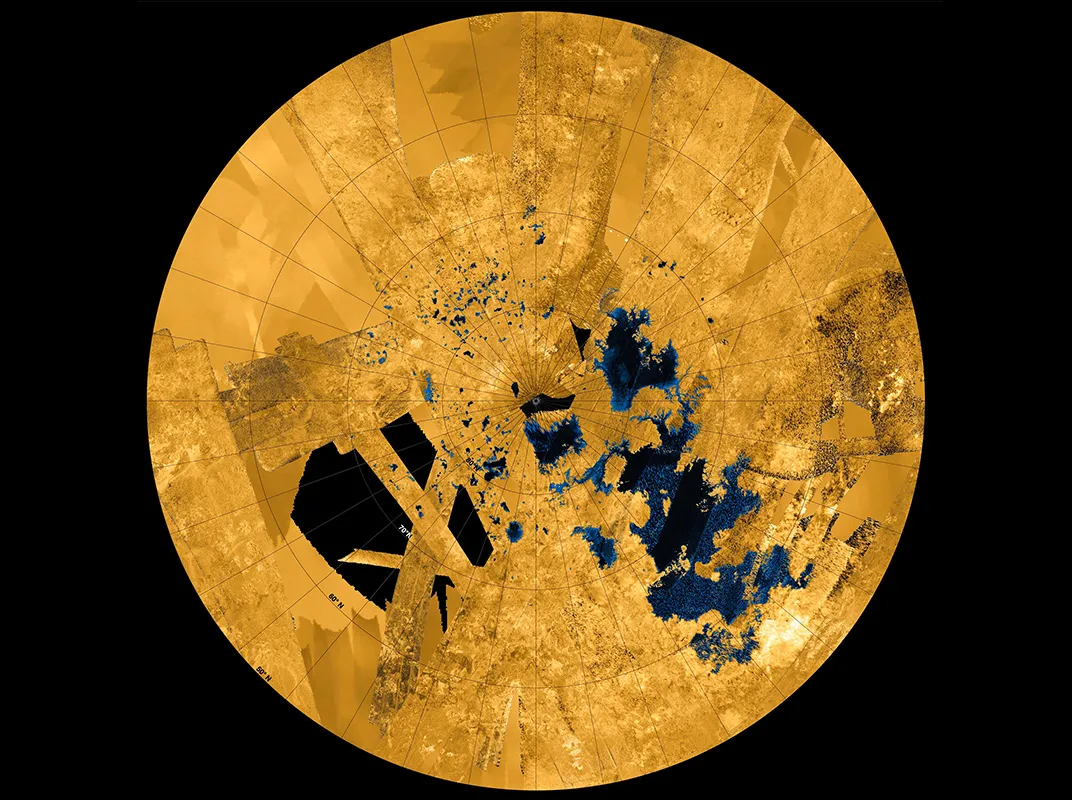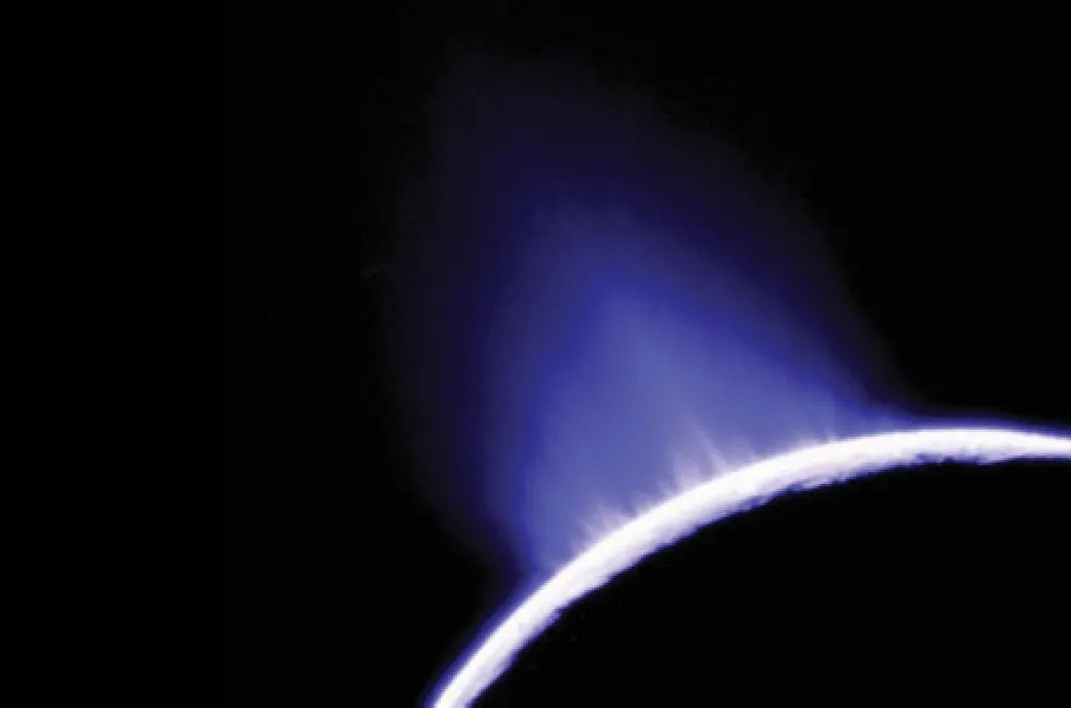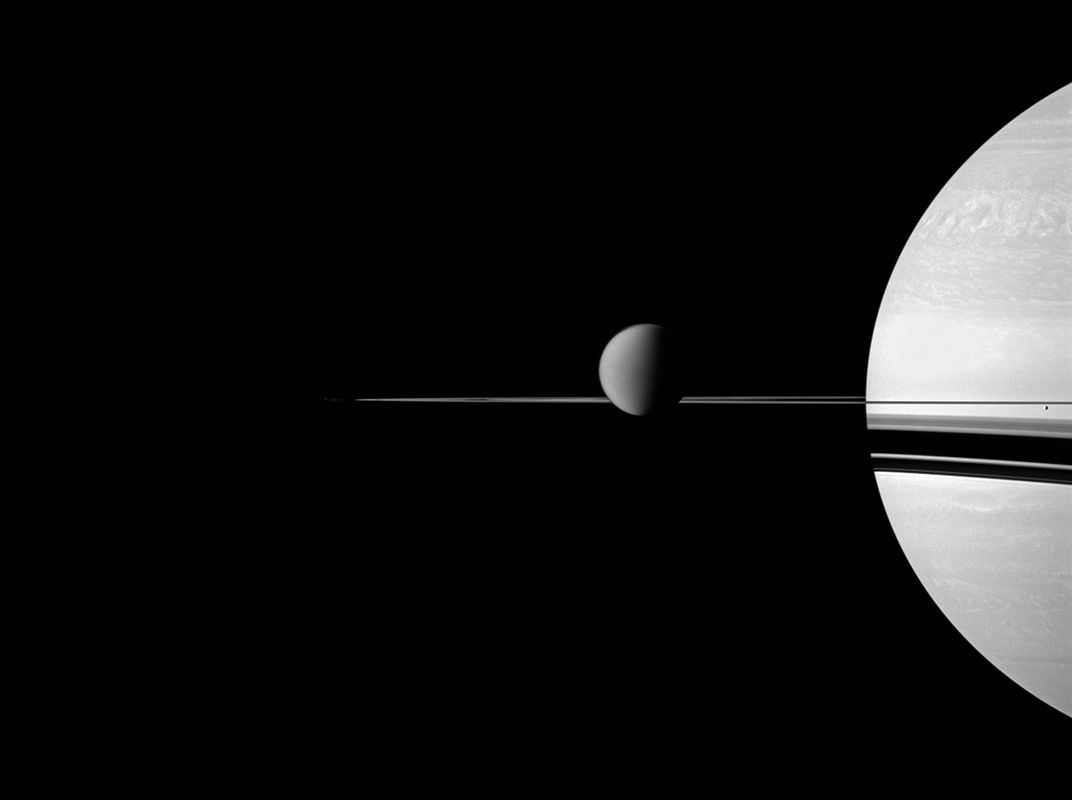Looking for Life Among the Gas Giants
The search for signs of biology on the moons of Jupiter and Saturn.
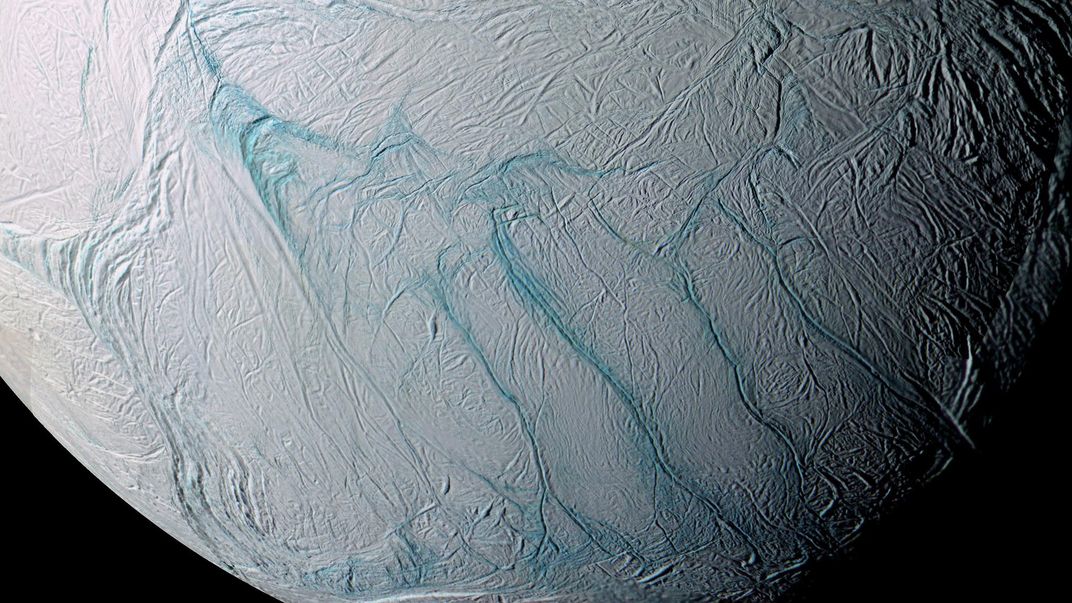
In the mysterious realm of the outer solar system, space probes have shown us worlds encrusted with ice, shrouded in haze, and pocked by lakes of methane. But as inhospitable as they seem, in the last few decades evidence has been piling up that several moons orbiting our solar system’s gas giants may have environments suitable for life. Not at some point in history, as with Mars, but today. Europa, which orbits Jupiter, and Enceladus and Titan, Saturnian moons, are targets of the next great search for life.
NASA has been filling in previously vague pictures of the outer solar system with the results of three planetary missions: the twin Voyager spacecraft, launched in 1977; the Galileo mission to Jupiter in the 1990s; and Cassini, which has been investigating the Saturn system since 2004. Scientists have spent decades analyzing the data from these explorers, mapping the contours and chemistry of more than 100 satellites around Jupiter and Saturn with enough accuracy to make solid guesses about where biological processes might be hidden.
If life is discovered, Kevin Hand might be the one announcing it. A planetary scientist and astrobiologist at NASA’s Jet Propulsion Laboratory in Pasadena, California, Hand is on the team for the new Europa Multiple Flyby Mission. It’s a mission idea that’s been championed strongly for about a decade under the working name Europa Clipper and that became reality last year, when federal funding was earmarked for the spacecraft and the study of a lander with the goal to launch by the mid-2020s. Hand co-chairs the group responsible for the spacecraft’s primary goal: assessing the moon’s habitability.
When the two Voyager spacecraft flew past the Jupiter system, they discovered something astounding: The moon Io has active volcanoes. The gravity of the giant planet and its large satellites causes tidal forces that heat the moon’s interior. Scientists quickly realized that those forces could very likely heat Europa enough to keep liquid the global ocean believed to be hidden under the smooth crust of ice on the surface. If the moon really has this large source of water, all it would need is organic material and some kind of energy to establish microscopic life forms.
When Galileo arrived to build upon the Voyager data, its measurements seemed to establish that Europa has a metallic core underneath a rocky mantle that provides the seabed for a salt water ocean—one whose volume is about twice that of all Earth’s oceans combined. Just in the last few years, scientists have used Galileo data to determine the likelihood of clay-like minerals on the moon, which might mean it also has organics (carbon molecules) as a result of hydrothermal activity on the ocean floor. On Earth, hydrothermal vents create energetic interactions between water and the minerals in the rocky seabed that can sustain life without direct energy from the sun. In the search for habitable worlds, the possibility that there’s carbon on Europa is provocative.
One of the intriguing features on Europa are lines that appear etched into its smooth ice crust. Scientists have come to believe these are healed cracks. The tidal forces that keep the ocean liquid also cause cracks in the ice; ocean water rushes up to fill them and freezes. The melting and refreezing of the ice is likely what keeps the surface relatively smooth. “We know that Europa is geologically active over the tens-of-millions-of-years time scale because we can look at the surface and see that there are essentially no large craters,” says Hand. There is one significant crater, Pwyll, and a couple others, but those are relatively young. Europa’s ice surface is about as old, geologically speaking, as the oceanic crust on Earth, which is “the youngest material on our planet—or perhaps second only to very active volcanoes,” says Hand.
So if you’re a scientist looking for environmental traits similar to those on Earth, the one place we know life has thrived, Europa looks more and more interesting, the more we learn about it. Increasing the allure: If a spacecraft could fly over the surface and find a crack in the ice, a lander could descend and sample the ocean directly. “Simply put, [Europa] is the place to go to look for living life today—life that we can someday poke and prod and see where a second origin of life has occurred in our own back yard,” says Hand.
Not everyone would have made Europa Target Number One. For one thing, there might be an easier way to find a living neighbor. Instead of sending a spacecraft out to orbit a far moon and then try to land it on an ice sheet to dig around for signs of life, what if we could send an emissary to merely pass near another moon to intercept material this body is spewing into space? That’s the case for Enceladus, one of many dozens of moons orbiting Saturn. This tiny world—it’s not even as wide as Wyoming—was virtually unknown until Cassini arrived. About a year later the probe discovered that Enceladus is shooting out plumes of icy particles. Cassini’s team was so excited they changed the spacecraft’s mission path to visit the moon more often.
The plumes are more of a slow drip than an Old Faithful-like eruption, but in the vacuum of space, that drip travels far enough from Enceladus’ surface for Cassini to easily fly through it. In flybys over the past decade, Cassini has recorded mounting signs of possible life on the body below. The plumes are made up of briny water in the form of gas, liquid, and solid particles. Those particles carry organics from what scientists have recently become sure is another worldwide ocean, just like Europa’s. Cassini has also detected silica particles, indicating hydrothermal systems on the sea floor that are leaching material into the water. But scientists cannot use Cassini to make the next leap in discovery. It is a 20-year-old spaceship with 20-year-old instruments. No one knew it would discover a habitable moon around Saturn, and even if astronomers had, the technology available when Cassini was built would not likely have been advanced enough to find life, if it exists on Enceladus.
So planetary scientist Jonathan Lunine wants NASA to send a mission he’s calling the Enceladus Life Finder. The Cornell professor, who has written two textbooks on astrobiology and habitable planets, developed the Life Finder with Chris McKay. A leader in the field of astrobiology and a scientist at NASA’s Ames Research Center in California, McKay has spent much of his career on the Cassini mission. Lunine presented the Enceladus Life Finder in early 2015, describing it as an upgraded version of Cassini “with mass spectrometers of much higher resolution, range, and sensitivity” that would “measure key chemical indicators of just how habitable Enceladus’ ocean is.” But the instruments would do much more than take a closer look at the moon’s environment: They would look for the patterns and processes that only biology could explain. The ELF could find life. And the best part: It could do all this in about 10 dives through Enceladus’ plumes.

Lunine and McKay proposed ELF for NASA’s latest round of Discovery missions. The agency chooses these cheaper solar system missions, currently capped at $450 million each, every two or three years. Mars Pathfinder, the Kepler space telescope, and Mercury orbiter MESSENGER were a few funded for the smaller amount, versus $2 to 3 billion for flagship missions like Cassini and the Europa Multiple Flyby Mission. The Life Finder was one of three Enceladus astrobiology missions submitted: The Jet Propulsion Lab and the California Institute of Technology proposed the Journey to Enceladus and Titan, or JET, and a large team including scientists from NASA, Arizona State University, Ball Aerospace, and the Japanese space agency—JAXA—proposed the Life Investigation for Enceladus, or LIFE, a spacecraft that would return a sample from the moon’s plume on a plug of aerogel, similar to how the Stardust mission brought back samples from a comet in 2006. But when NASA selected five finalists last September, it passed over the outer-moon missions, instead opting for two missions to study Venus and three to observe asteroids and near-Earth objects. “It was a little bit ahead of its time,” says Lunine about ELF. The idea was sound, but NASA required more technical readiness for the spacecraft’s instruments.
That’s why the Europa mission is good news for Enceladus fans. The Multiple Flyby spacecraft will be carrying the same mass spectrometer Lunine wants for ELF, and a similar instrument to determine the composition of dust particles. (Flagship missions carry so many more instruments, NASA grants them slightly more leeway in technical readiness; if one instrument fails, the mission can still send home plenty of data.) Once those are under construction, it will make moot any questions about ELF’s technical maturity.
Another issue the Europa mission might greenlight for ELF is its propulsion source. To stay under budget, the Enceladus mission would almost certainly have to use solar power. (Larger missions are powered by RTGs—radioisotope thermoelectric generators—which require manufactured plutonium, an element that is expensive and in short supply.) But NASA evidently felt that a mission to Saturn using just solar power “was still a stretch,” Lunine says. Juno, the spacecraft set to arrive in the Jupiter system later this year, and the Europa spacecraft will both use solar power, and Lunine thinks that “once NASA breaks that mental barrier,” ELF will be approved. “It’s an important technology to validate for Saturn missions,” he says. “Saturn has such an interesting set of worlds around it that we want to go back, and we’re going to need solar power to do it.” Lunine and his team hope that by the next time they have an opportunity to propose “it’ll be a slam dunk.”
There is a third moon where scientists want to look for life, and this is where everything gets weird. “I’m going to be a bit mischievous and say I’m a Titan man,” says Planetary Science Institute senior scientist David Grinspoon, who was the Library of Congress’ first chair holder in astrobiology in 2013. The Saturn moon has life-nurturing attributes undreamed of on its two icy rivals. It is the only moon in our solar system known to have a substantial atmosphere, one that is rich in complex organic molecules. In addition to water hiding under the surface, as on Europa and Enceladus, Titan also has liquid right at the surface. In 2014, Cassini sent back images of sunlight glinting off gigantic lakes near Titan’s poles. (It also sent the Huygens probe down in 2005; scientists hoped it would land on open ocean, but our first look at the surface through Titan’s haze was of soft, dry, dust-like material.) The moon has precipitation, storms, and seasons. The catch: Those above-ground lakes seem to be made of methane, which will stay liquid at Titan’s typical temperature—around -300 degrees Fahrenheit. “So it’s a high-stakes visit, let’s put it that way, to the seas of Titan,” says Lunine.
Grinspoon’s response is the astrobiological equivalent of Well, nobody’s perfect. “If we think of what life needs, chemical reactions and cyclic energetic behavior, Titan’s got that,” he explains. “We are focused on water-based life because that’s what we are made of. But we don’t know what else the universe is capable of.” A few years ago, the Maryland-based firm Proxemy Research pitched NASA on a mission called Titan Mare Explorer, or TiME, which essentially would have landed a small boat with an antenna on those methane expanses. The last time NASA chose a Discovery mission, in 2012, the project made it to the final round of three competitors, but the agency picked one more Mars explorer, the InSight lander.
“There are three places we need to go look for life, and we should be going to all of them,” says Lunine. “But the strategy is different for each of these objects, and right now we know more about the habitable environment of Enceladus than we do about either Titan’s or Europa’s oceans.” Astrobiologists mostly agree about the first part—Let’s go everywhere—but they’re debating the second: where to start. “If we could go to both [Europa and Enceladus] at the same time, I would do that because Enceladus’ chemistry has proved to be fascinating,” says Hand. But as for whether the moon has the best conditions for life, he’s not convinced. “Even though we have no equation for the origin of life, we think you need liquid water, the elements needed for life [organic molecules], some energy source [like Earth gets from the sun’s radiation], some sort of catalytic surface [where all those pieces can interact and kickstart a biological process], and then you need time.” And it’s that last one where Enceladus comes up short, Hand says: “We don’t fully understand why or whether Enceladus’ ocean has been around for a long time.” Some models say the moon has had an ocean for as long as the Saturn system has existed, but Hand says Enceladus is so small it could have acquired its entire ocean from a relatively recent meteor impact. Europa, on the other hand, is far too big to have gotten all its water that way, so it almost surely should have existed long enough for life to take hold.
McKay doesn’t understand that argument. “Most people have the prejudice that life started on Earth, and that it took billions of years,” he says. “But we have no data to support either of those statements.” All he knows is that we have directly observed both water and organics on Enceladus. No such observations have been made on Europa.
There’s a bigger problem to surmount at Europa. Jupiter’s magnetosphere is already massive due to the planet’s giant size, and made even stronger by electrical currents produced by metallic hydrogen in Jupiter’s outer core, as well as the plasma produced by the volcanic activity on Io. The resulting radiation poses a problem for any spacecraft in the system. Mission planners will plaster the Europa spacecraft in protective shielding, but instruments will still have to poke out, so the craft will undertake a flyby mission, rather than orbit the moon. Its path will take big swings—45 of them—past Europa to avoid staying too long in the heat. “It’s sort of like running into the fire and grabbing some valuables and running out, then waiting a little bit and going back in,” says McKay. That strategy won’t be possible for the potential Europa lander, though, so McKay sees this effort as a geophysical mission: one that will be helpful to map out the surface and add to the evidence for habitability—but one that’s unlikely to find life itself.
You might also wonder: With so much radiation there, wouldn’t it kill off any life? Says Hand, “The radiation at Europa may actually be critical to the ecosystem.” Any life in the ocean will be protected from direct exposure by the ice crust, and in fact, irradiation of the ice is creating things like molecular oxygen and hydrogen peroxide—“all compounds that microbial ecosystems and, frankly, ecosystems of complex organisms love to chew on,” says Hand. Now the question is whether NASA’s robotic lander could survive the radiation long enough to tap into any ecosystem that might be thriving because of it.
The discovery of microscopic beings beneath Europa’s or Enceladus’ ice would be an epic breakthrough in human knowledge. “We are searching for a second example of biochemistry that could help us understand our own,” McKay explains. “Our current position is like only having an apple. Think how much more you can understand about an apple when you have an orange to compare it to.” The current age of exoplanet discovery adds piquancy to NASA’s hunt for tiny life forms in our own solar system, says Seth Shostak, who, as the director of the SETI Institute, searches for signals from distant intelligent life forms. “Twenty years ago we thought planets were rare,” he says. “Now we think that 70 to 80 percent of stars actually have them. If Europa proves that a planet can come up with life if you give it the right chemical ingredients and leave it alone for a while, imagine what could be going on other places.”
Scientists pushing for any of these outer moon missions should be buoyed by an announcement that David Schurr of NASA’s Planetary Sciences division made in January: Both Enceladus and Titan are being eyed for a New Frontiers mission—a medium-class mission like Juno or New Horizons, the spacecraft that flew by Pluto. For the next few decades, astrobiology is one of NASA’s priorities. If the agency’s missions find what the scientists hope, the next generation of Earthlings will be the first to grow up knowing all about the alien neighbors just down the road.

